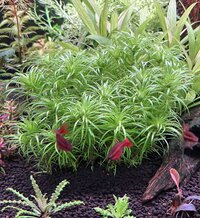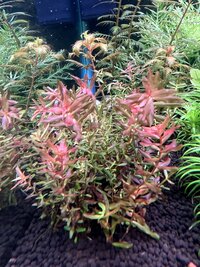Idea is this:
Each species has a unique demand for all things nutrient wise. Even some species can make certain chemical compounds that others cannot to assist them with moderating heavy metals etc.
The plant does the tasks and to fulfil the tasks, it requires nutrients (all of them). It can take the nutrients from the soil via roots and the water column via shoots. The leaf acquisition of nutrients is different than the root (root is very good at getting nutrients from soil - with assistance of rhizosphere, etc) and Leaf is not as good (see the paper I linked above when talking about K). So all the N/P that comes in via water gets forced into the leaf as example - yet the roots don’t burn in Amazonia soil (for example) … these are different things.
K allows the exchange of those nutrients from roots up to grow.
So suppose N/P/Ca/Mg maybe some Cu and some B get into the leaf and all your CSM mix etc but the particular plant need a bit more Zn … it gets it from the substrate given you have enough K to facilitate (concentration etc). The thing is more on N/P, they have such a large influence on growth rates that if you lard in those N and P, you are driving growth and anything that is lacking needs to be topped up from soil. It’s possible you exhaust your soil of Zn and then have to play with micros to get it right. But if you don’t, then it will exhaust the next and the next until you chase the targets for the “time”.
That is why I said soil is the name of the game. Go inert, then keep targets and keep it immaculately clean - the moment you don’t, it begins to start skewing things potentially —- since inert has no CEC, the N will liberate into the column and even though rhizosphere can assist in N across root membrane to get the N into the tissue to top up the demand facilitated by K, if the bacteria make it N before the root gets it, it goes into Column and drives growth via leaves — it does that and then you need K to top off the difference (all the while hammering co2 properly), but your soil is inert so you have nothing to top off, so deficiency. And the deficiency and stunting you see is associate with whatever happens to be lacking. So you dose the lacking thing and rinse and repeat new deficiency.
All this to say, if you want to preserve soil, dosing lean will do so. But I mean, can dose EI and make gargantuan plants - many of us have dons 3-5x EI for fun. It works. But your precious substrate is gone in a few months.
EDIT: what you put in the water is forced to be used by the plant and if it is not correct proportions for the growth, the plant tops itself up from soil. If you dose less in water, then the bank account (substrate) doesn’t run dry as quickly (there is lower bound to what you can put in water). The soil bank doesn’t force itself into the root - roots are different.
Feel I have rambled but certainly don’t want to fill your journal with this stuff.
I’m keen to see how it all pans out

. I think everyone can agree you are really trying to squeeze out perfection - tank is lovely.



 .
.
